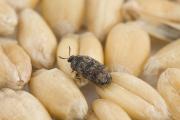Secondary pests of stored grain
Rust-red flour beetle (Tribolium castaneum)
The rust-red flour beetle is frequently found on farms in WA. It is a reddish brown beetle about 3mm long. The final three segments of its antennae are greatly enlarged to form a club shape. Young adults are pale brown in colour becoming darker with age. Females lay up to 1000 eggs loosely scattered throughout infested grain. Cream-coloured larvae with biting mouth parts and three pairs of legs hatch and remain free from the grain, feeding on cereal dust and damaged grains. A generation takes about one month to complete under summer conditions, but longer in cold weather. Adults may live up to a year. The adult is winged and may fly.

Confused flour beetle (Tribolium confusum)
The confused flour beetle closely resembles the rust-red flour beetle in appearance and life history except for the antenna segments which do not have a distinct three-segmented club at the end. It is more often found in flour mills than on farms, as it prefers more finely divided materials.

Saw-toothed grain beetle (Oryzaephilus surinamensis)
The saw-toothed grain beetle is common on WA farms. Adults are dark brown to black with six tooth-like projections on each side of the thorax. They lay up to 500 eggs loosely spread through the infested grain; eggs hatch to produce larvae which feed externally on grain dust and sometimes wheat embryos. The mature larvae pupate within a silken cocoon. A complete generation may take place in as little as three weeks but the adults may live up to nine months. They frequently hide in cracks and crevices of buildings and machinery.

Flat grain beetle (Cryptolestes spp.)
Flat grain beetles are small reddish brown insects about 1.5mm long with long antennae and a flattened body. Eggs are laid throughout the stored grain and develop into tiny larvae with characteristic tail horns, biting mouth parts and three pairs of legs. They feed on damaged grain and wheat embryos. Pupation takes place in a cocoon. A complete life cycle takes from 4-5 weeks and adults may survive up to one year.
Warehouse moth (Ephestia spp)
The warehouse moth is a drab grey moth with a 10-12mm wingspan. It usually only infests the surface of stored grain. Moths live for only about two weeks, but during that time lay up to 200 eggs. These are distributed loosely on the grain surface. Larvae hatch out of the eggs and wander over the grain surface leaving a trail of silk which may form a thick mat covering the surface of the infested grain. Mature larvae pupate in a silk cocoon among the grain or on the walls of the building. The life cycle takes at least four weeks.

Indian meal moth (Plodia interpunctella)
The adult Indian meal moth is grey with distinctive brownish-red tips to the forewings. The female lays up to 200 eggs near the grain surface as it slowly passes from grain to grain spinning a silk thread. Severe infestations may form a surface web on the grain heap. Larvae attack the wheat germ, then pupate in a cocoon which may be found in cracks and crevices of buildings. The insects quickly emerge as adult moths. A generation takes as little as four weeks under warm conditions.

Warehouse beetle (Trogoderma variable)
This beetle was first found in WA in 1989 and that infestation was eradicated. It has now spread to about a dozen locations in WA but has never established to damaging populations.
The warehouse beetle is a pest of stored grain in its own right, but the greater threat is the impact on trade that it could have by masking an incursion of the world's worst pest of stored grain — the khapra beetle. Warehouse beetle and khapra beetle require microscopic examination to distinguish them. Khapra beetle does not occur anywhere in Australia and would have a severe impact on international trade if it became established.
Eggs are usually laid in crevices and under the surface of loose food. They hatch in about a week. Only the larval stage damages grain. It is frequently found in seeds, groceries and used sacks. The larvae are conspicuously hairy. They usually live for about five weeks but may enter a dormant phase (diapause) for more than two years. Larvae may moult up to ten times.
After pupation adults emerge. They are less obvious than the larvae and do no damage to grain. They live for up to five weeks during which females lay up to 80 eggs. Warehouse beetles cannot fly and are spread only in infested commodities and old sacks.
A characteristic of warehouse beetle infestations is the accumulation of cast larval skins. Hairs shed by larvae may cause asthma, skin or gastric problems.
It is impossible to distinguish between T. variabile and several harmless native species without the aid of a microscope. Any hairy larvae found in grain stores should be sent to DPIRD for positive identification.


Insecticide resistance
Insect populations of many species have evolved resistance to insecticides as a result of the widespread use of these chemicals in control. In some cases, insects which have only been exposed to one insecticide develop resistance to other, related compounds.
It takes many years and millions of dollars to develop and test new compounds. Therefore it is important that insecticide resistance is prevented from spreading. This may be achieved by appropriate use of pesticides and by farm hygiene. This consists of careful cleaning of all machinery and buildings used for storing and transporting grain right from the header to the port terminal.
